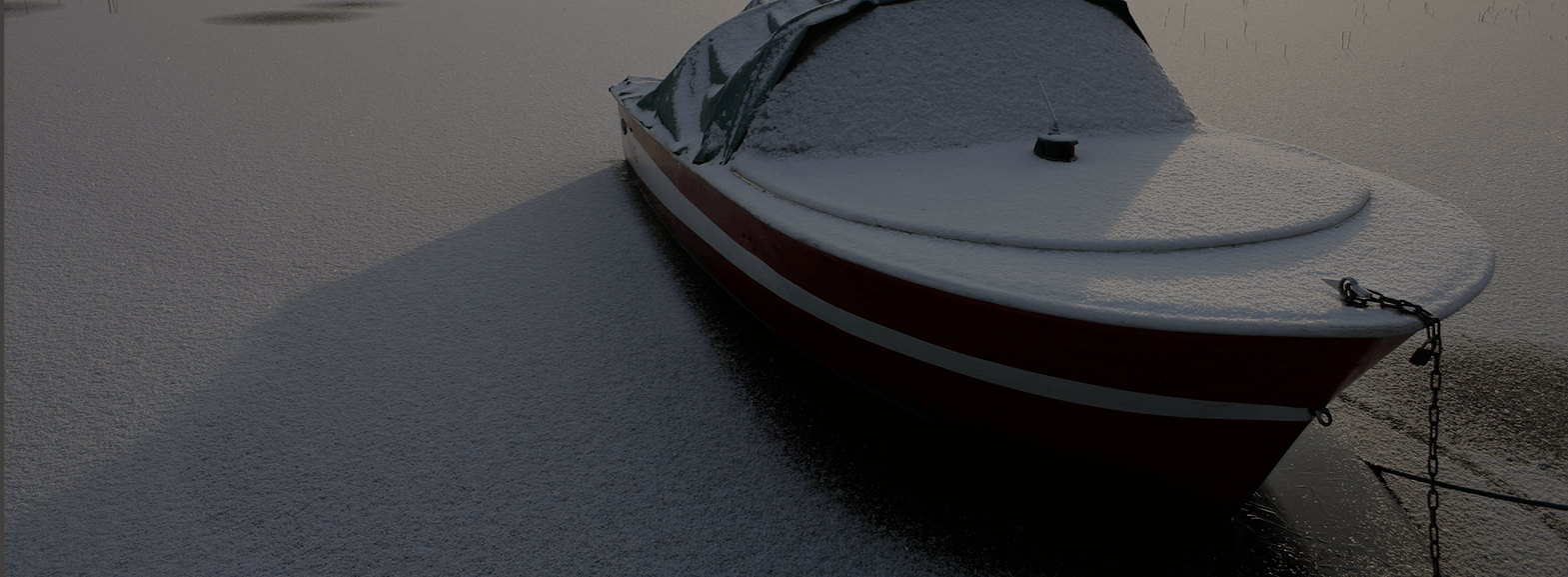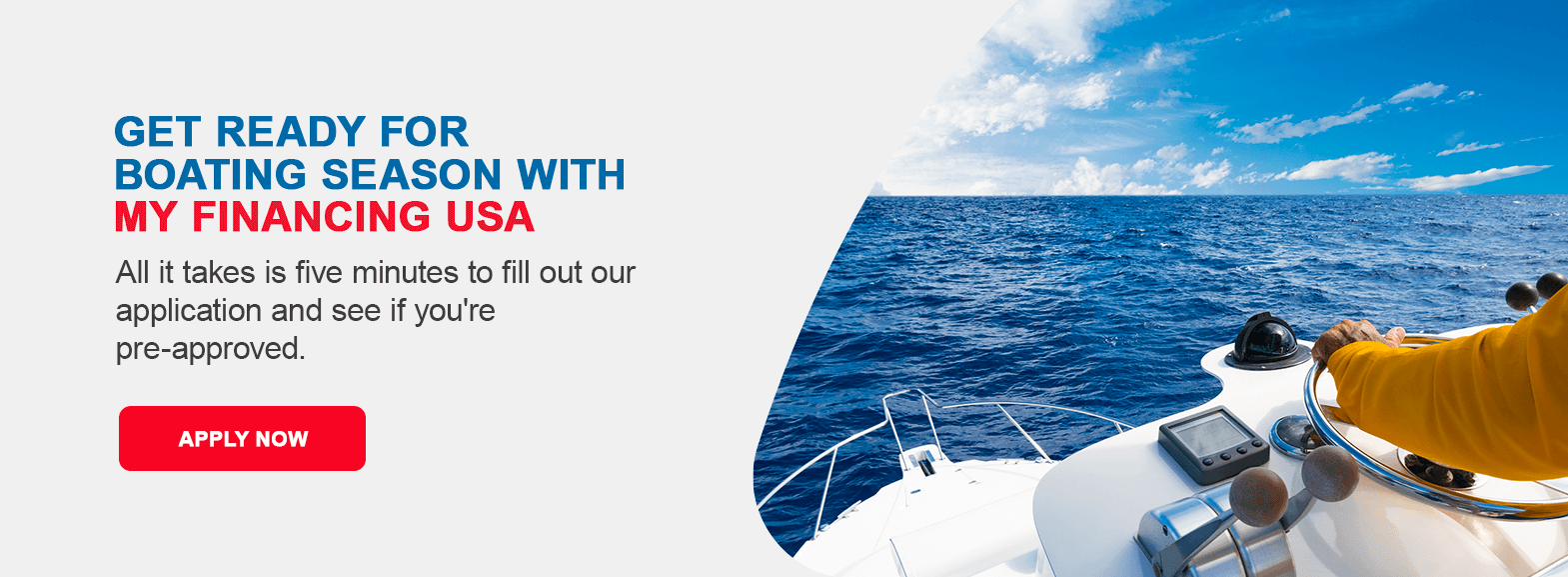Quick Navigation:
- When Is It Safe To De-Winterize a Boat
- Boat De-Winterization Checklist
- Boat De-Winterization FAQs
- How To De-Winterize a Boat Step-By-Step
- 1. Take Off The Tarp Or Wrapping
- 2. Get Rid Of Any Animals
- 3. Check The Engine and Change the Oil
- 4. Check The Gas Tank
- 5. Service Your Water Pumps And Cooling Systems
- 6. Check The Battery
- 7. Check The Fuel System
- 8. Check The Lines, Connections And Belts
- 9. Check Any Cables And Hoses
- 10. Clean The Distributor
- 11. Inspect The Bilge Pump
- 12. Make Sure The Electronics Work
- 13. Inspect The Interior And Exterior
- 14. Service The Bottom Of Your Boat
- 15. Inspect The Safety Gear
- 16. Inspect The Trailer
- 17. Give Your Vessel A Cleaning And Polish
After a long winter of shoveling snow, freezing weather and staying inside, it's finally time to break the boat out of storage and get it back into the water where it belongs. While you may only be weeks away from lounging in the sun and cruising on the water, there is still plenty of work to be done before you can take your vessel on the high seas.
If you are one of the many Americans who own a boat, then you know that the first signs of spring are telling you it's time to de-winterize your boat. If this past winter was your first one as a boat owner, then you may not know how to de-winterize your boat, or even where to start.
This inclusive guide will show you everything you need to know about de-winterizing a boat. From how to de-winterize a boat motor to de-winterizing a boat water system, we'll go over how to get your boat ready for the summer sun in just 10 easy steps. We'll even provide you with a complete checklist for de-winterizing boats of all types and answer the most common questions about getting a vessel ready for peak season.
When Is It Safe to De-Winterize a Boat?
De-winterizing any boat, whether it's an inboard-outboard, an inboard or an outboard, has to be done at just the right time. The purpose of winterizing your boat is to protect it from the harsh temperatures during winter. If there is any water in the cooling, water or plumbing systems, you risk sustaining serious damage to your vessel. Since water expands as it freezes, containers and water lines can crack if water is left inside.
Knowing when to de-winterize a boat is just as important as learning how to de-winterize it. Determining when to begin the de-winterizing process will depend on where you live. Boat owners in southern states will be able to take their vessels out of storage much sooner than those who live in northern states that are more susceptible to early spring snowstorms.
So, when is it safe to de-winterize a boat for boat owners in northern states? The rule of thumb is that you can start de-winterizing when the temperatures at night no longer drop below freezing. The temperatures during the day are usually warmer because the sun is out. However, northern states can still experience snow and frost at night into the months of March and April.

If you keep your eye on the weather forecast for a few weeks and determine that the last frosts of winter are behind you, then it's finally time to pull your boat out of storage and start de-winterizing.
How to De-Winterize a Boat Step-By-Step
If this is your first time de-winterizing a boat, remember to take it one step at a time and pay attention to the small details. De-winterizing is really about inspecting the interior and exterior for small fractures, leaks and other signs of damage. Take your time with every step so that you don't miss potential problems that may arise when you finally get back out on the water.
1. Take Off the Tarp or Wrapping
Although you're eager to get inside your vessel and make yourself at home, the first step of de-winterizing a boat is to remove the tarp or wrapping that's covering it and check the outer shell.
If you skipped the final step of covering your boat when you winterized it and just put it into storage without a tarp, then you'll have to spend a few hours cleaning months' worth of grime and dirt off of it. Even if you did cover your vessel for the winter, you may still find mice, insects, birds or even snakes in the nooks and crannies around the outside of your boat.
If you wrapped your boat, but stored it outside, then you'll need to inspect the roof as well. Heavy snowfall and winter storms can cause structural damage, which will have to be fixed before you put the boat back in the water.

2. Get Rid of Any Animals
This step goes along with removing the tarp of your boat - but unfortunately animals sometimes take shelter in your boat during the winter months, especially if you haven’t checked on your boat in a while. For this reason, we recommend checking on your boat several times throughout the winter, as pests like mice can destroy the wiring and more of your boat. You should also keep an eye out for roasts, snakes, and more.
Once you uncover your boat, inspect it - including all the nooks and crannies - to make sure there are no unwanted pests. You can also consider using pest repellant before you winterize your boat to protect yourself beforehand.
3. Check The Engine and Change the Oil
Experienced boat owners know that the first interior system to check is the engine. De-winterizing boat engines can be done by yourself if you are confident in minimal mechanical work, or you can enlist a professional's help if you want to save time and energy.
To de-winterize boat engines, you will have to change the oil and filter, as well as inspect the outdrive. After months of being inactive, your engine will benefit from oil additives. An oil additive will provide extra lubrication and keep your engine clean and free of corrosion. Refreshing the oil doesn't just prevent your engine from rusting over time. It keeps the fuel lines and belts in working condition.
After you have checked the boat's engine, take a few minutes to inspect the propeller. Make sure there are no dents, cracks or corrosion on the blades or shaft.
Don't worry if you have an outboard engine instead of an inboard model. The process for how to de-winterize an outboard boat motor is essentially the same as how to de-winterize an inboard boat motor.
4. Check the Gas Tank
In addition to checking the engine, make sure you also check out your gas tank for rust. Check that the fuel hasn’t gone bad as well.
5. Service Your Water Pumps And Cooling Systems
The most crucial step to preparing your vessel for spring is de-winterizing your cooling system and water pumps.
When you winterized your boat, you should have flushed and added antifreeze to the cooling system. Draining the cooling system prevents the coolant line from freezing and cracking. To de-winterize boat water systems, you will have to flush and drain the cooling system again, then refill it. Make sure to check the hoses for cracks and holes, as well as empty the strainer. To replace the antifreeze, use an equal mixture of a diluted coolant and water.

To de-winterize boat water pumps, start with checking the impeller. This part is crucial to your boat's performance. It keeps water flowing down to cool the engine and should be replaced about every 300 hours or two or three years — whichever occurs first.
Check your thermostat as well by following your engine manufacturer's recommended procedures. Your thermostat regulates the water temperature. If it isn't working properly, then your engine can overheat or become too cold.
Finally, connect the wires for your spark plugs, and your cooling system is ready.
6. Check the Battery
If you winterized your boat properly, then you unplugged the battery before placing your boat in storage. Between the cold weather and lack of use, your battery can come out of the cold months a little worse for wear.
To test your battery, first top it off with distilled water to prevent impurities from entering the unit. Then use a battery tester to ensure it's fully functioning. Make sure to bring your battery to a full charge before testing it. If it is working correctly, then give it a good cleaning and install it. If the battery isn't working or holding a charge, then you'll have to replace it.
When you’re ready to test your battery, make sure it is filled with water and test it with a battery tester. If it tests well, clean off any corrosion from the terminals and install. If it does not test well, you will probably save yourself time, headaches and money by going ahead and replacing it.
7. Check the Fuel System
While the cooling system needs to be drained during the winterization process, the fuel tank should have been filled with a fuel stabilizer to prevent moisture from building up during the winter months. To de-winterize inboard boat or outboard boat fuel systems, the first thing you need to do is check the fuel line for cracks and leaks. In frozen temperatures, the rubber of the fuel lines can easily crack and become brittle.
If for some reason you put gas in your tank without a stabilizer, then you'll need to drain it out. Without a stabilizer, the fuel can separate, become contaminated or go stale. Make sure to use a quality non-ethanol and additive fuel combination when refilling the tank. This will prevent any damage from occurring.

Next, change the fuel filter from the last season and check that the exhaust and ventilation systems are working.
8. Check the Lines, Connections and Belts
Checking the belts and connections throughout your vessel is a crucial step to preparing for prime boating season. You can tell if a belt is worn and needs to be replaced by simply pressing down on it. All of the vessel's belts should be tight with very little give. If your belt is malleable or starts wearing under pressure, it needs to be replaced.
Another method of inspecting the condition of a belt is to look for soot around the pulleys. If there is soot, that indicates that the belt is worn and should be replaced.
Similarly, lines and connections can be affected by the presence of colder temperatures. Fuel lines are susceptible to cracking, and electrical connections can fall victim to corrosion. While experienced boat owners may know how to address electrical and mechanical issues, it's always recommended that vessels are taken to a professional when there is damage in these areas.
9. Check Any Cables and Hoses
Cables and hoses in your boat can get some wear and tear with the winter, especially if they are made of rubber, since cold temperatures can break down rubber. Go through your boat and check all cables and hoses to make sure they ar still tight and secure.
10. Clean the Distributor
Distributors can corrode during the winter months, so make sure to clean it as you de-winter your boat. Check the distributor cap and the connections.
11. Inspect the Bilge Pump
Check the bilge pump, the automatic switch, and the circuit to make sure they are working correctly.
12. Make Sure the Electronics Work
Check out any navigational instruments, such as a GPS or depth meter, as well as any other electronics, such as speakers and fridges, to make sure they are all working properly. This will vary from boat to boat, but it’s important to look into the specific electronic devices on your boat before setting sail to make sure they are working correctly.
13. Inspect the Interior and Exterior
While your boat may have been in pristine condition when you winterized it and put it into storage, anything can happen when it's tucked away for so long. From insect infestations and mice nibbling at the wires and cushions, to mildew buildup and water damage, you never know what problems you'll find in and beneath the hull.
From the outside, you should be looking for new dents that can turn into leaks, signs of water damage and split seams. Check underneath the cushions and any other fabric surfaces for dampness and mold.
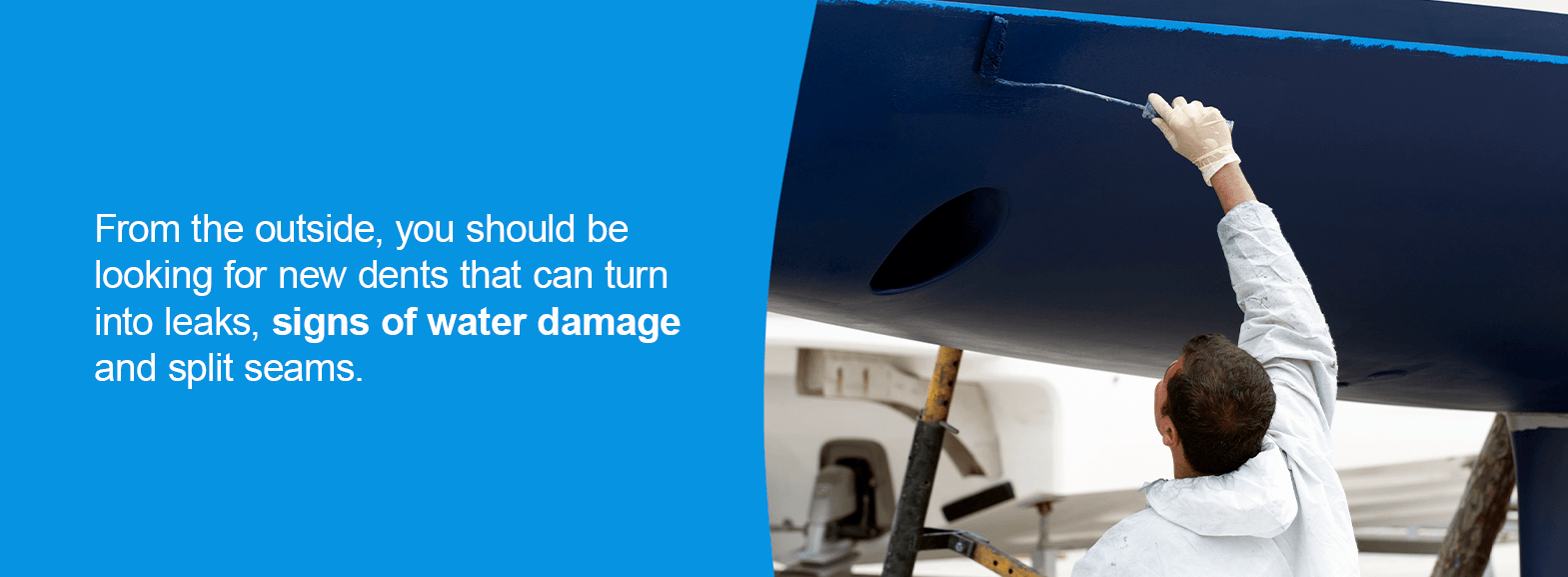
Remember that a boat sinks because water enters it. Even the most minimal damage can cause major problems if not addressed right away.
14. Service the Bottom of Your Boat
How do you de-winterize the underside of your boat, and is it even necessary? While you may not notice the belly of your boat because it's usually in the water, it still requires some care and attention.
The first step to servicing the bottom of your boat is giving it a good power wash, although you shouldn't use too much pressure. This will help to clear away the dirt, dust and mildew that may have collected during the off-season. It will also show you any dents or cracks in the hull. If applicable to your vessel, you should also sand and scrape the bottom.
The simple maintenance of washing off the belly of your boat will reinforce the integrity of the moldings and prevent structural damage to the fiberglass.
When the bottom of your vessel is clean, apply a fresh coat of oil if it is made of wood. If your boat is painted, give it a coat of anti-fouling paint to prevent rotting and keep it squeaky clean. Maintaining your boat's condition means servicing every inch of it, even the parts that you don't normally see when boating.
15. Inspect the Safety Gear

Servicing the motor and cooling systems are undoubtedly important steps in de-winterizing your vessel. However, inspecting the safety gear on your boat can end up saving a life.
You need to check all of your safety equipment to make sure it is in working order and up-to-date. Fire extinguishers and flares do expire, so you have to routinely check their expiration dates all year round.
Check that all your life jackets and floatation devices are accounted for and in good condition. Go through your first aid kit and restock any supplies that have dwindled down, such as bandages, gauze, antiseptic wipes, cold compresses and aspirin.
It's important to be ready for any emergency situation, so when in doubt, refer to this list for essential safety gear:
- A bucket
- Flashlights
- Fire extinguishers
- Flares
- A first aid kit
- Throwable floatation devices
- Extra batteries
- Garbage bags
- A portable phone charger
- A marine radio
- Life jackets
16. Inspect the Trailer
You may not have a tow trailer, but if you do, make sure to check it out for any corrosion and rust. Check the springs, brackets, tires, wheels, and brake lights to make sure everything is running smoothly and safely.
17. Give Your Vessel a Cleaning and Polish
You're finally almost ready to take your vessel out on the water, but you still need to complete the final step of de-winterization — cleaning and polishing your boat. After all, you want your boat to shine and stand out as the beautiful vessel it is.
When you're done cleaning and waxing the hull, make sure to do a once-over of your electronics, navigational system and lights. Finally, check your trailer to make sure it is in working order and didn't rust.
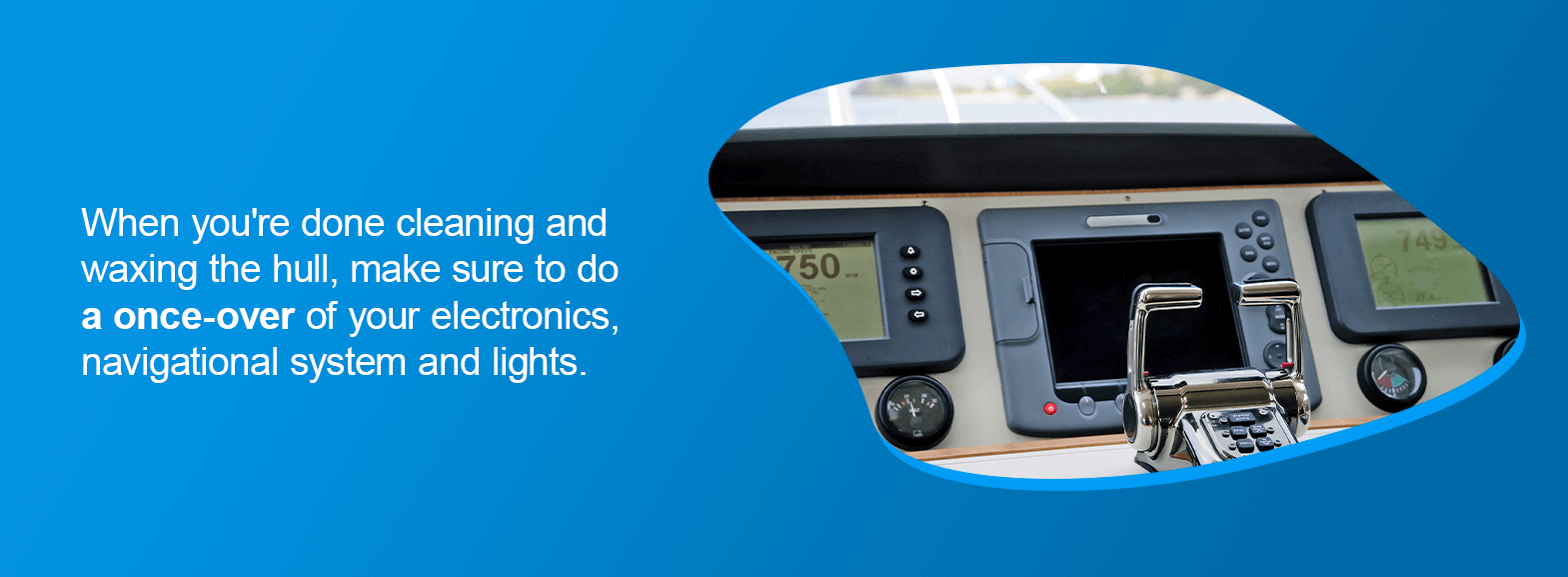
Now your boat is officially ready to be taken out to sea for the summer!
Boat De-Winterization Checklist
Don't let the length or work of the process deter you from tackling this task head-on. This de-winterizing boat checklist will help keep you on track and on task.
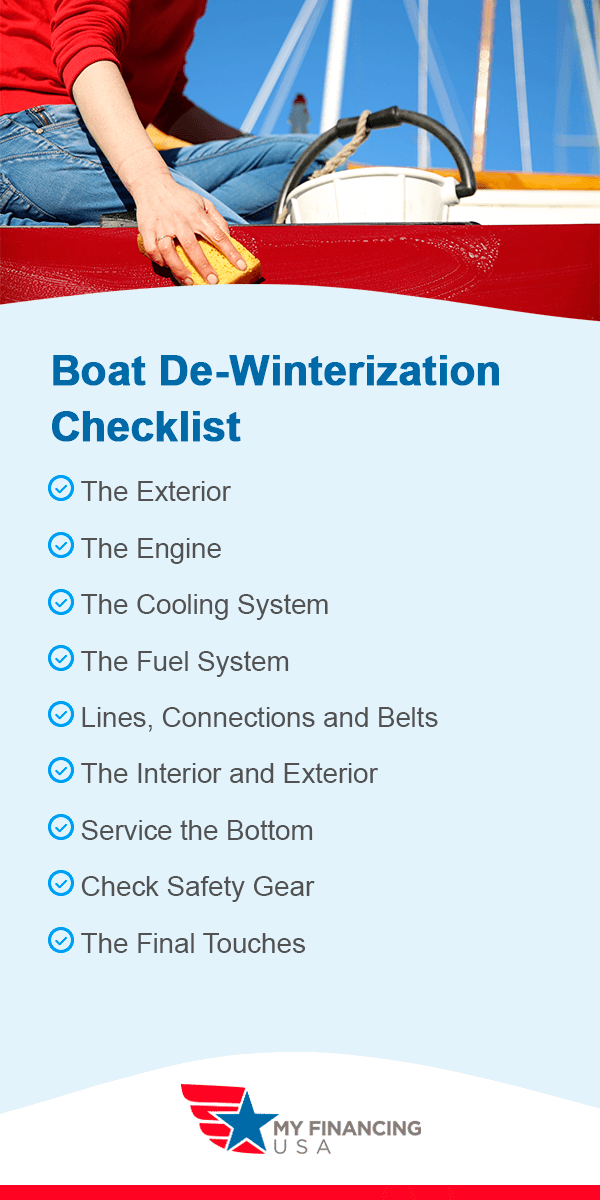
The Exterior
- Remove the covering.
- Check the hull for cracks, dents, holes and chipped paint.
- Inspect the roof for damage.
- Look for evidence of pests.
The Engine
- Inspect the outside for dents and corrosion.
- Change the oil.
- Replace the oil filter.
- Check the fuel lines and belts.
The Cooling System
- Flush the antifreeze from the system.
- Check the hoses for cracks and holes.
- Empty the strainer.
- Check the impeller and have it replaced if necessary.
- Check the thermostat and replace it if needed.
- Reconnect your spark plugs.
The Fuel System
- Check the hoses, connections and tanks for leaks and damage.
- Replace damaged or brittle components.
- Secure clamps and fittings.
- Refill your tank with fuel that has less than 10% ethanol.
Lines, Connections and Belts
- Test the belts to ensure they are taut.
- Inspect the lines for cracks and wear.
- Check the electrical connections for corrosion.
The Interior
- Check the cabin for cracks and water damage.
- Inspect cushions and fabrics for mildew, rips or other damage.
- Look inside cupboards and lockers for mold.
- Deep clean surfaces and disinfect seating areas.
Service the Bottom
- Clear away debris with a power washer.
- Inspect the surface for damage.
- Repair any damage.
- Sand, scrape and wipe down the bottom if necessary.
- Give it a new coat of paint.
Check Safety Gear
- Check the date of the fire extinguisher.
- Check and restock flares.
- Inspect life jackets.
- Put floatation devices in areas that are accessible.
- Restock your first aid kit.
- Check marine radio function and batteries.
- Refill essential items such as toiletries and garbage bags.
The Final Touches
- Clean the outside of your vessel.
- Give it a polish.
- Check the electronics.
- Make sure the navigational system is functioning.
- Check navigation lights.
- Inspect the trailer.
Boat De-Winterization FAQs
Many new boat owners have the same questions when it comes to de-winterizing and summertime boat maintenance. Here's a look at the most common concerns of boat de-winterization.
Do You Need to Winterize a Boat in the First Place?
If you live in the South or any place that has milder winters, you might be wondering whether you need to winterize your boat. The answer is always yes! Winterizing protects your boat from adverse weather and, at the very least, requires you to conduct important maintenance. The small adjustments you pushed off making during peak season can now be addressed. This means everyone from Maine to Florida to California should winterize and de-winterize their boats.
How Much Will It Cost to De-Winterize My Boat?
The cost to de-winterize will vary depending on the type of boat you have. Some boats are easy to de-winterize, and some of the work can be done by yourself. However, some vessels will require repairs from professionals and will inevitably cost more. You can also save yourself time and effort and pay a professional to de-winterize it for you.
The greatest determinant will be how well you winterized your boat at the beginning of winter. If you did a good job and were thorough, then you most likely won't run into any issues. However, if you cut corners or forgot a step, then you may be looking at some damage.
What's the Difference Between De-Winterizing an Inboard Boat and Outboard Boat?
There are quite a few different types of watercraft, so winterizing and de-winterizing each one will vary slightly depending on which kind you have.
If you're wondering how to de-winterize an inboard-outboard boat, there aren't a lot of differences from outboards and inboards. The process requires the same attention to the engine, cooling system and exterior. You'll have to flush the motor, change the oil and clean and lubricate all the mechanical parts. The steps and procedures mentioned throughout this article still apply to your vessel, regardless of where the motor is placed.
Get Ready for Boating Season With My Financing USA
My Financing USA stands out as the leader in personal financial services. With nationwide resources and unparalleled customer service, we find the best rates for your boat loans so you can enjoy your new vessel without putting your finances at risk.
Still not sure a boat loan is right for you? Visit our information page and see our process for yourself. When you're ready, all it takes is five minutes to fill out our application and see if you're pre-approved. Fill out an application today!

